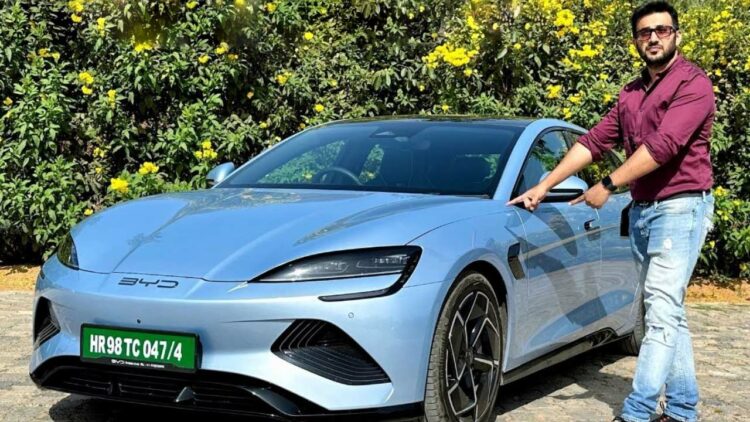We recently had the opportunity to test drive and review the BYD Seal EV. BYD has been in India for a while now. It offers the e6 electric MPV and Atto 3 electric crossover. But with the Seal, the Chinese carmaker marks a new beginning in the entry-level premium electric car category in India. There are not a whole lot of direct rivals to the Seal. Still, considering the price point, we can consider the Hyundai Ioniq 5 and Volvo XC40 Recharge as the two main rivals. Note that in the international markets, BYD Seal is a fierce competitor to the Tesla Model 3. Hence, it would be interesting to see the comparison between the two once Tesla comes to India. For now, let us share our experience of the BYD Seal with you.
You may also like: BYD Seal vs Tesla Model 3 Comparison – Which One’s Better?
BYD Seal EV Review – Exterior Design
I must admit that the BYD Seal looks unlike anything else on the road. This ensures a unique road presence which will definitely make heads turn. Since the carmaker has focused on aerodynamics, the front section of the Seal is extremely slippery with flowing curves on the bonnet. Other notable aspects are a prominent LED headlamp unit with C-shaped LED DRLs, a sporty bumper, a low-slung stance and more. On the sides, there are elegant 19-inch alloy wheels, pop-out door handles, black B pillars and a black element on the fender. At the rear, the Seal gets a connected LED taillamp panel, which is quite common these days. All in all, the BYD Seal certainly looks ultra-modern and unique.
Interior and Features
The modern amenities continue inside the cabin too. We know that Indian customers are fond of the latest tech and convenience features. BYD has ensured that it offers incredible functionalities and aesthetics to grab the attention of potential buyers. The list of amenities is quite extensive. These include things like a 10.25-inch LCD instrumentation display, a 15.6-inch rotating digital infotainment display, a silver-plated panoramic glass roof, soundproof double-glazed glass for the windshield and front door, a 12-speaker DYNAUDIO music system, 2 wireless smartphone charging slots, PM2.5 and CN95 air filters, Voice Assistant, NFC Key Card, ventilated and heated front seats, an 8-way powered driver seat with 4-way powered lumbar support, a 6-way powered passenger seat, ADAS active safety functions and more. In fact, it boasts a full 5-star ANCAP and Euro NCAP safety rating.
You may also like: BYD Seal vs Atto 3 – Specs, Features, Price Comparison
Specs
The BYD Seal comes in multiple variants and configurations to cater to the demands of all sorts of customers. There are three variants on offer – Dynamic, Premium, and Performance. We had the mid-trim (Premium) for our review. The buyers can choose between either a 61.44 kWh or an 82.56 kWh Blade Battery pack. There are single-motor RWD and dual-motor AWD alternatives depending on whether you are looking for maximum range or performance. The RWD iteration with the smaller battery pack delivers 150 kW (201 hp) / 310 Nm, while the larger battery offers an impressive 230 kW (308 hp) / 360 Nm.
However, things get to a whole new level in the performance-focused AWD guise. The dual-motor setup produces a jaw-dropping 390 kW (523 hp) / 670 Nm of peak power and torque allowing an acceleration from 0 to 100 km/h in just 3.8 seconds. That is supercar territory. On the NEDC procedure, the Seal can achieve a driving range anywhere between 510 km and 650 km on a single charge. This can translate to over 400 km in real-world situations. There is a 150 kW DC fast charger for the top two trims and a 110 kW DC fast charger for the base model. The prices range from Rs 41 lakh to Rs 53 lakh, ex-showroom.
| Specs | BYD Seal |
| Battery | 61.44 kWh or 82.56 kWh |
| Power | 201 hp – 523 hp |
| Torque | 310 Nm – 670 Nm |
| Range | 510 km – 650 km (NEDC) |
| Charging | 150 kW DC |
| Length | 4,800 mm |
| Width | 1,875 mm |
| Height | 1,460 mm |
| Wheelbase | 2,920 mm |
You may also like: BYD Seal vs Kia EV6 – Specs, Features Comparison
Drive Impressions
Then we head out on the road with the BYD Seal. As mentioned previously, we had the mid-trim Premium variant. Hence, it comes with a regular powertrain. Still, the performance was surprisingly good. In the Eco and Normal modes, the acceleration is decent and you can still overtake on the highways. But once you switch to Sports mode, things change drastically. The responses are much sharper and the acceleration gets brisk. Apart from that, the handling is excellent due to the inherent low-slung nature of the sedans.
That aids the driving dynamics immensely. Hence, you will feel confident carrying speeds into the corners. Also, the ride quality is great and the suspension setup soaks most bumps easily. But the condition of our roads is not ideal. Outside the major cities and expressways, the suspension system will constantly be working. Still, the BYD Seal offers great comfort to the passengers. All in all, we were thoroughly impressed by this ‘normal’ powertrain as well. We can’t wait to get our hands on the performance monster.
You may also like: 15 Upcoming Electric SUVs in India – Tata Punch EV to Kia EV9
Author’s Note
After the Govt. of India announced the new EV Policy, carmakers like Tesla are excited to enter our market. Under this policy, it will be able to offer its EV at attractive prices. Once Tesla cars are here, it would be a head-on fight between these two. Until then, I am very intrigued to see how well people embrace the BYD Seal. Note that the prices of the Seal are very compelling. We shall have to wait a bit longer to see how well the Seal does on the sales charts.



